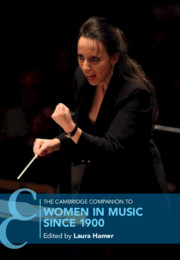Book contents
- The Cambridge Companion to Women in Music since 1900
- Cambridge Companions to Music
- The Cambridge Companion to Women in Music since 1900
- Copyright page
- Dedication
- Contents
- Figures
- Boxes
- Notes on Contributors
- Preface
- Abbreviations
- Part I The Classical Tradition
- 1 Women in Composition before the Second World War
- 2 Women in Composition during the Cold War in Music
- 3 Behind the Iron Curtain: Female Composers in the Soviet Bloc
- 4 Still Exceptional? Women in Composition Approaching the Twenty-First Century
- 5 On the Podium: Women Conductors
- 6 Soloists and Divas: Evolving Opportunities, Identity, and Reception
- In Her Own Words: Practitioner Contribution 1
- Part II Women in Popular Music
- Part III Women and Music Technology
- Part IV Women’s Wider Work in Music
- Appendix: Survey Questions for Chapter 14, The Star-Eaters: A 2019 Survey of Female and Gender-Non-Conforming Individuals Using Electronics for Music
- Select Bibliography
- Index
- References
6 - Soloists and Divas: Evolving Opportunities, Identity, and Reception
from Part I - The Classical Tradition
Published online by Cambridge University Press: 17 April 2021
- The Cambridge Companion to Women in Music since 1900
- Cambridge Companions to Music
- The Cambridge Companion to Women in Music since 1900
- Copyright page
- Dedication
- Contents
- Figures
- Boxes
- Notes on Contributors
- Preface
- Abbreviations
- Part I The Classical Tradition
- 1 Women in Composition before the Second World War
- 2 Women in Composition during the Cold War in Music
- 3 Behind the Iron Curtain: Female Composers in the Soviet Bloc
- 4 Still Exceptional? Women in Composition Approaching the Twenty-First Century
- 5 On the Podium: Women Conductors
- 6 Soloists and Divas: Evolving Opportunities, Identity, and Reception
- In Her Own Words: Practitioner Contribution 1
- Part II Women in Popular Music
- Part III Women and Music Technology
- Part IV Women’s Wider Work in Music
- Appendix: Survey Questions for Chapter 14, The Star-Eaters: A 2019 Survey of Female and Gender-Non-Conforming Individuals Using Electronics for Music
- Select Bibliography
- Index
- References
Summary
Chapter 6 shifts the focus to female performers within the classical music industry. Francesca Placanica considers the increased opportunities which female performers, both singers and instrumentalists, gained throughout the twentieth and twenty-first centuries, not only in terms of being able to achieve star status, but also through being able to integrate into professional orchestras. Focusing upon the trumpeter Alison Balsom and percussionist Dame Evelyn Glennie, she considers the new opportunities that have developed over recent decades for women to maintain careers as virtuosa performers of instruments historically deemed unsuitable for women to play. Placanica also deftly probes the high degree of sexualisation which many contemporary performers, including Yuja Wang, Katherine Jenkins, and Vanessa Mae, face in the contemporary classical music industry and how this can be negotiated in a mediatised culture.
Keywords
- Type
- Chapter
- Information
- The Cambridge Companion to Women in Music since 1900 , pp. 80 - 94Publisher: Cambridge University PressPrint publication year: 2021

